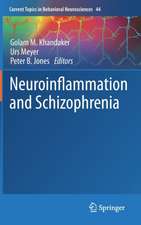Therapeutic Intranasal Delivery for Stroke and Neurological Disorders: Springer Series in Translational Stroke Research
Editat de Jun Chen, Jian Wang, Ling Wei, John H. Zhangen Limba Engleză Hardback – 17 iun 2019
Preț: 780.68 lei
Preț vechi: 952.05 lei
-18% Nou
Puncte Express: 1171
Preț estimativ în valută:
149.38€ • 155.97$ • 123.63£
149.38€ • 155.97$ • 123.63£
Carte tipărită la comandă
Livrare economică 04-18 aprilie
Preluare comenzi: 021 569.72.76
Specificații
ISBN-13: 9783030167134
ISBN-10: 3030167135
Pagini: 142
Ilustrații: VI, 153 p. 11 illus., 8 illus. in color.
Dimensiuni: 155 x 235 mm
Greutate: 0.4 kg
Ediția:1st ed. 2019
Editura: Springer International Publishing
Colecția Springer
Seria Springer Series in Translational Stroke Research
Locul publicării:Cham, Switzerland
ISBN-10: 3030167135
Pagini: 142
Ilustrații: VI, 153 p. 11 illus., 8 illus. in color.
Dimensiuni: 155 x 235 mm
Greutate: 0.4 kg
Ediția:1st ed. 2019
Editura: Springer International Publishing
Colecția Springer
Seria Springer Series in Translational Stroke Research
Locul publicării:Cham, Switzerland
Cuprins
Preface.- Transnasal Induction of Therapeutic Hypothermia for Neuroprotection.- Hypoxia-Primed Stem Cell Transplantation in Stroke.- Therapeutic potential of intranasal drug delivery in preclinical studies of ischemic stroke and intracerebral hemorrhage.- Intranasal Drug Delivery after Intracerebral Hemorrhage.- Intranasal Treatment in Subarachnoid Hemorrhage.- Intranasal Delivery of Therapeutic Peptides for Treatment of Ischemic Brain Injury.- Intranasal delivering method in the treatment of ischemic stroke.- Intranasal Delivery of Drugs for Ischemic Stroke Treatment: Targeting IL-17A.- Intranasal tPA application for axonal remodeling in rodent stroke and traumatic brain injury models.- Therapeutic Intranasal Delivery for Alzheimer’s disease.- Combination therapy of intranasal IGF-1 and hypothermia.- Intranasal Medication Delivery in Children for Brain Disorders.- Index.
Textul de pe ultima copertă
The blood-brain-barrier prevented harmful materials entering the brain and in the meantime is a barricade to therapeutic drug delivery. Intranasal drug delivery to circumvent blood-brain-barrier was developed in the past, to take advantages of a secret passage from the olfactory epithelium into the brain—bypassing the tight junctions that encapsulated the brain from blood circulation. This timely publication of Therapeutic Intranasal Delivery for Stroke and Neurological Disorders presented some of the latest advances in intranasal delivery research, including transnasal hypothermia induction, stem cell intranasal transplantation, intranasal drug delivery in ischemic and hemorrhagic models, intranasal peptides delivery, intranasal tPA application in adults and children.
Editors Jun Chen, Jian Wang, Ling Wei and John Zhang are professors from University of Pittsburgh, Johns Hopkins University, Emory University and Loma Linda University in USA.
Editors Jun Chen, Jian Wang, Ling Wei and John Zhang are professors from University of Pittsburgh, Johns Hopkins University, Emory University and Loma Linda University in USA.
Caracteristici
Comprehensive overview of studies of intranasal delivery Expected to have great impact on the field of translational stroke research Useful for researchers, physicians, and drug developers?








































